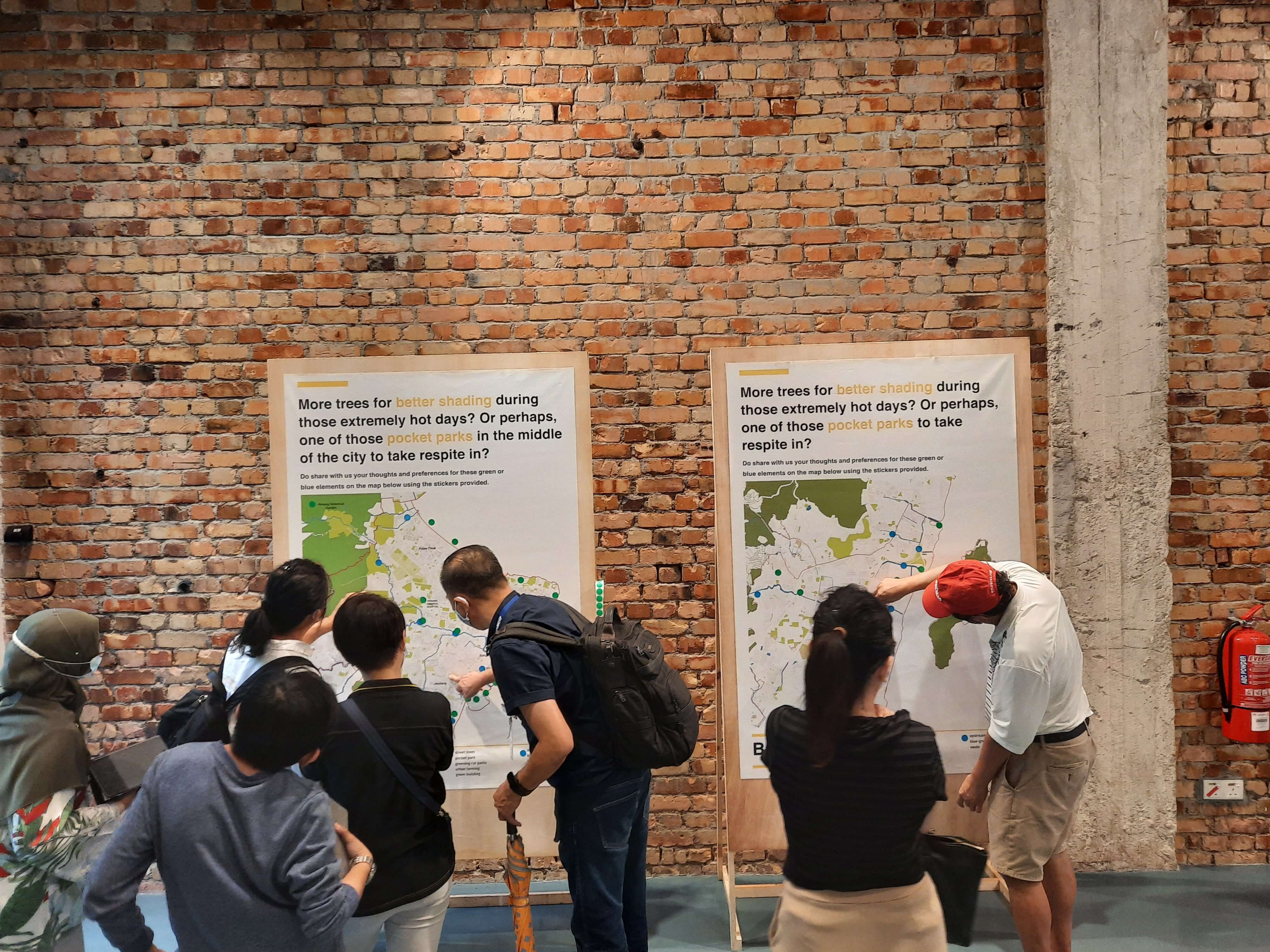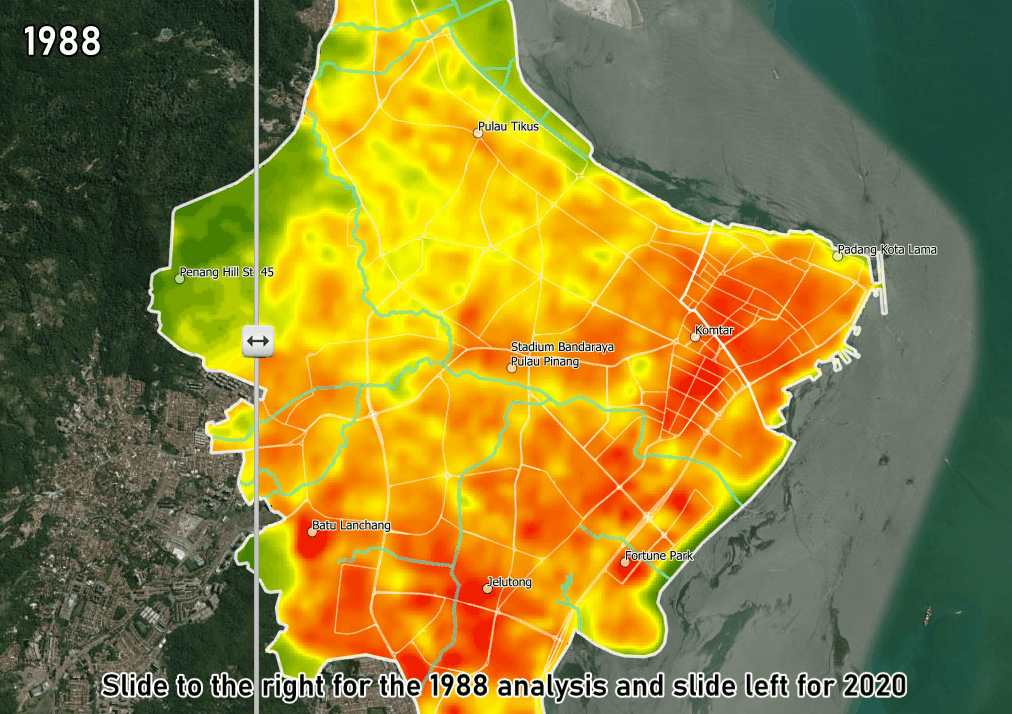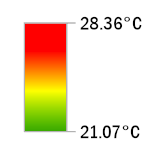George Town: Land Surface Temperature
(1988 & 2020)
Slide right for 1988 analysis, left for 2020.
A study by Think City showed an increase of 6.37°C in George Town's surface temperature between 1988 and 2020.
In February 1988, the highest recorded surface temperature in George Town was 28.36°C, while the lowest was 21.07°C. Land surface temperature (LST) was particularly high in Kompleks Tun Abdul Razak (KOMTAR) and Jalan Dato' Keramat. In 1988, the hottest location was a former tin smelting plant (now Penang Times Square) in Jalan Dato' Keramat which reported temperatures over 28°C.
In February 2020, the highest and lowest recorded temperatures were 34.73°C and 24.30°C - an increase of 6.37°C between 1998 to 2019's highest recorded temperatures. The rise occurred across all of George Town, including Penang Hill in the west. Locations reaching temperatures over 34°C were located in Batu Lanchang, Jelutong, Fortune Park Industry, KOMTAR and the George Town World Heritage Site (GTWHS).

Part of George Town's festivals: Penang International Food Festival (Courtesy: Penang Global Tourism)
After receiving UNESCO's World Heritage status in 2008, George Town has become more attractive to the public and visitors and has been highly concentrated with human activities. The UNESCO's inscription had also deterred the pace of gentrification in George Town, protecting its traditional landscapes and the vital social and cultural connections between different generations living in the city. However, George Town has been proven to be highly susceptible to the impacts of climate change (e.g. heat stress, sea level rise, extreme weather events).

Community participation in urban greening efforts in the climate adaptation programme
In 2019, a nature-based climate adaptation programme for Penang's urban areas was drawn up from the multilateral efforts of local public and private organisations, civil society, and Think City. This ongoing initiative is in response to climate change effects (e.g. LST) and extreme weather events that pose a detrimental risk to the social and urban resilience of Penang's urban areas, including George Town. The programme, which will start implementation in 2021, will see the executions of nature-based based solutions such as urban greening and agriculture, and expansion of blue-green corridors in George Town to control the rising surface temperatures, flooding risks and Urban Heat Island (UHI) effects.
Methodology
LST is measured by collecting specific data (e.g. thermal, red and near-infrared bands) from a Landsat dataset to feed into a Geographic Information System (GIS) model, which then processes and combines the data with relevant parameters to determine the final LST value. Key parameters include top of atmosphere reflectance and brightness temperature, thermal emissivity and vegetation health data.
Disclaimers
The methodology does not include the direct collection of physical and biological information of objects (e.g. manmade, vegetations, water bodies, etc) in the study areas; rather it is based on a remote quantitative estimation of LST values, which can greatly vary depending on changes in surface energy. Surface temperature data are prone to errors due to clouds and cloud shadows, thus certain areas may have their temperatures underestimated. Temporal measurement is different for each city as timeframes could not be standardised (except for George Town and Bayan Lepas) due to data limitations; and was captured by two different satellites (Landsat 5 and Landsat 8) with slightly different thermal sensing capacity. Study areas also varied in sizes and some may show greater extremes in temperature change due to the capacity of larger areas to evolve and change (e.g. accept more substantial physical changes; for example, Johor Bahru district has more spatial capacity for further development compared to Kuala Lumpur City Centre).
References
►Hashim, N.B.M., Ahmad, A. and Abdullah, M., 2007. Mapping urban heat island phenomenon: Remote sensing approach.
The Institution of Engineers, Malaysia, 68, pp.25-30.
►Malakar, N.K., Hulley, G.C., Hook, S.J., Laraby, K., Cook, M. and Schott, J.R., 2018. An operational land surface temperature product for Landsat thermal data: Methodology and validation.
IEEE Transactions on Geoscience and Remote Sensing, 56(10), pp.5717-5735.
►Mustafa, E.K., Co, Y., Liu, G., Kaloop, M.R., Beshr, A.A., Zarzoura, F. and Sadek, M., 2020. Study for Predicting Land Surface Temperature (LST) Using Landsat Data: A Comparison of Four Algorithms.
Advances in Civil Engineering, 2020.
►Cook, M., Schott, J.R., Mandel, J. and Raqueno, N., 2014. Development of an operational calibration methodology for the Landsat thermal data archive and initial testing of the atmospheric compensation component of a Land Surface Temperature (LST) product from the archive.
Remote Sensing, 6(11), pp.11244-11266.
Sources
Data source: United States Geological Survey (USGS)
Data sets: Landsat Missions 5 and 8

Land Surface Temperature of George Town
Land surface temperature of George Town, Penang in 1988 and 2020.


